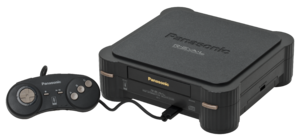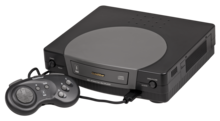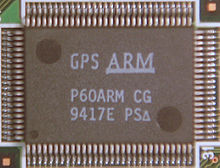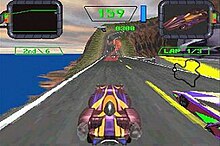3DO
| File:3DO Interactive Multiplayer logo.png | |
 Panasonic FZ-1 R.E.A.L. 3DO Interactive Multiplayer | |
| Developer | The 3DO Company |
|---|---|
| Manufacturer | Panasonic, Sanyo and GoldStar (now LG Corp) |
| Type | Video game console |
| Generation | Fifth generation era |
| Discontinued | December 31, 1996[1] |
| Units sold | 2 million[2] |
| Media | CD-ROM |
| CPU | 32-bit 12.5 MHz RISC CPU ARM60 based on ARM architecture |
| Online services | Planned but canceled |
| Successor | M2 (canceled) |
The 3DO Interactive Multiplayer (often called simply the 3DO) is a video game console developed by The 3DO Company. The 3DO was released in North America on October 4, 1993, in Japan on March 20, 1994, and in Europe in 1994. The system was conceived by entrepreneur and Electronic Arts founder Trip Hawkins.[1]
Instead of The 3DO Company producing the console themselves, they licensed other manufacturers to produce them. Panasonic produced the first models in 1993, and further renditions of the hardware were released in 1994 by Sanyo and GoldStar (now LG Corp). The consoles were manufactured according to specifications created by The 3DO Company, and were originally designed by Dave Needle and R. J. Mical of New Technology Group.
Despite a highly promoted launch (including being named Time magazine's "1994 Product of the Year") and a host of cutting-edge technologies, the 3DO's high price (US$699 at launch),[3] The 3DO however was able to sell over 2 million console worlwide, and had over 400 game titles with plenty of third-party support for the system.[4]
History
The 3DO Interactive Multiplayer was originally conceived by The 3DO Company, founded in 1991 by Electronic Arts founder Trip Hawkins. The company's objective was to create a next-generation, CD-based video game/entertainment standard which would be manufactured by various partners and licensees; 3DO would collect a royalty on each console sold and on each game manufactured. To game publishers, the low $3 royalty rate per game was a better deal than the higher royalties paid to Nintendo and Sega when making games for their consoles. The 3DO hardware itself was designed by Dave Needle and R.J. Mical, starting from an outline on a restaurant napkin in 1989.[5] Trip Hawkins recalled,
I'd actually known those guys for a while and we are kindred spirits ... and it turned out that they had already started working on designing a next generation system and they had made some very important decisions that were the same decisions that I would have made (architecture and approach). Rather than me start a brand new team and starting from scratch it just made a lot of sense to ... join forces with them and shape what they were doing into what I wanted it to be.[5]
The 3DO Company lacked the resources to manufacture consoles themselves, and instead licensed the hardware to other companies for manufacturing. Trip Hawkins recounted that they approached every electronics manufacturer, but that their chief targets were Sony and Panasonic, the two largest consumer electronics companies in the world.[5] However, Sony had already begun development on their own console, the PlayStation, and ultimately decided to continue work on it rather than sign with 3DO.[5] Panasonic launched the 3DO with its FZ-1 model in 1993, though Goldstar and Sanyo would later manufacture the 3DO as well.
Licensing to independent manufacturers made the system extremely expensive. The manufacturers had to make a profit on the hardware itself, whereas most major game console manufacturers, such as Sega and Sony, sold their systems at a loss, with expectations of making up for the loss with software sales. Some sources claim that 3DO was priced at $699,[2][6] far above competing game systems and aimed at high-end users and early adopters. Hawkins has argued that 3DO was launched at $599, and not "higher myths that are often reported."[3] He clarified in a later interview that the official list pricepoint was $699, but that very few retailers actually sold it at that price.[5] Goldstar (LG) and Sanyo 3DO models, as well as Panasonic's later FZ-10 model, were all less expensive to manufacture than the FZ-1 model, and as such sold for considerably lower prices. In addition, six months after launch the FZ-1 had already dropped its price to $499, leading some to contend that the 3DO's cost was not as big a factor in its market failure as is usually claimed.[5]
The launch of the platform in October, 1993 was well-promoted, with a great deal of press attention in the mass media as part of the "multimedia wave" in the computer world at the time. Return Fire, Road Rash, FIFA International Soccer, and Jurassic Park Interactive had all been slated for launch release, but were pushed back to mid-1994 due to the developers' struggles with the then cutting edge hardware; as a result, the only 3DO game software available at launch was the third-party game Crash 'n Burn.[5][7]
The 3DO despite its eventual struggles started off strong. with many developers jumping on board. In december 16th more than 500 licensed software providers were making software for the 3DO.[8] With 13 titles ranging from strategy, simulations, and action games, and with the Panasonic 3DO being shipped to over 2000 retailers. In the first month of 1994, there were 43 different pieces of software shown at winter CES.[9]
The 3DO was also released before the advent of the ESRB, which was created after controversial games such as Night Trap and Mortal Kombat. Because of the lack of ratings on software, the 3DO created the first rating system for all games on the platform until the ESRB was established later. The ratings were E for everyone, 12 for 12 year olds, 17 for 17 year olds, and AO for Adults only games.[10]
3DO later launched in japan at roughly $500 converted from Yen, and included 11 software titles: Chiki Chiki Machine Race by Future Pirates Inc., Crash 'N Burn by Crystal Dynamics, Dragon's Lair by T&E Soft, Fire Ball by Japan Data Works, Kyoto Mystery by Pack-In Video, Pebble Beach Golf Links by T&E Soft Stellar 7 - Draxon's Revenge by T&E Soft, Total Eclipse by Crystal Dynamics, Ultraman Powered by Bandai, Virtual Horror by Electronic Arts, and Virtual House - The Life Stage by Micro Cabin.
Variants


Due to the licensing method employed by 3DO a number of different manufacturers produced the 3DO system for the market. The Panasonic versions are the best known and most common.
- Panasonic FZ-1 R.E.A.L. 3DO Interactive Multiplayer (Japan, Asia, North America and Europe) — The first 3DO system, which was initially priced at $699.99 in the U.S. The price was later reduced to $399.99 in the fall of 1994.[11]
- Panasonic FZ-10 R.E.A.L. 3DO Interactive Multiplayer (Japan, North America and Europe) – Released a year or two after the FZ-1. It is a less expensive, slimmer and lighter model and replaced the FZ-1 in Panasonic's portfolio. The FZ-10 featured a top loading CD tray, an internal memory manager and repositioned the LEDs and controller port. The controller is also smaller and lighter than the one included with the FZ-1, but lacks a headphones output.
- Panasonic ROBO 3DO (Japan only) — A FZ-1 custom console, fitted with a five disc CD drive.
- Goldstar 3DO Interactive Multiplayer (South Korea, North America and Europe) — The Goldstar (LG) GDO-101M unit, released a year after the FZ-1, is similar in physical appearance to the Panasonic model. However, due to hardware differences and file processing limitations, incompatibilities with some games were reported.
- Goldstar 3DO ALIVE II' (South Korea only)
- Sanyo TRY 3DO Interactive Multiplayer (Japan only)
The 3DO Blaster was an add-on produced by Creative Labs and designed to allow compatible Windows-based PCs to play games for the 3DO console.
- Creative 3DO Blaster — PC ISA expansion card with a double-speed CD-ROM drive and one controller that enables a PC to play 3DO games.
Hardware
The original edition of the console, the FZ-1, was referred to in full as the 3DO REAL Interactive Multiplayer. The console had advanced hardware features at the time: an ARM60 32-bit RISC CPU, two custom video coprocessors, a custom 16-bit DSP and a custom math co-processor. It also featured 2 megabytes (MB) of DRAM, 1 megabyte of VRAM, and a double speed CD-ROM drive for main CD+Gs or Photo CDs (and Video CDs with an add-on MPEG video module).[1] The 3DO included the first light synthesizer in a game console, converting CD music to a mesmerizing color pattern.
The 3DO is one of few CD-based units that feature neither regional lockout nor copy protection, making it easy to use pirated software.[12] Although there is no regional lockout present in any 3DO machine, a few Japanese games cannot be played on non-Japanese 3DO consoles due to a special kanji font which English language consoles could not read. Games that have compatibility issues include Sword and Sorcery (which was released in English under the title Lucienne's Quest), the adult video game Twinkle Knights and a demo version of Alone in the Dark.

Technical specifications
Processor
- 32-bit 12.5 MHz RISC CPU (ARM60)
- Custom Math co-processor (It does not use the stock ARM FPA unit.)
- 32kb SRAM


Display
- Resolution 640×480 (interpolated), 320×240 (actual) 60 Hz for NTSC version, and 768×576 (interpolated), 384×288 (actual) 50 Hz for PAL version with either 16 bit palettized color (from 24 bits) or 24 bit truecolor.[13]
- Two accelerated video co-processors capable of producing 9–16 million pixels per second (36–64 megapix/s interpolated), distorted, scaled, rotated and texture mapped.
System board
- 50 MB/s bus speed (synchronous 32-bit @12.5 MHz bus)
- 36 DMA channels
- 2 MB of main RAM
- 1 MB of VRAM
- 2 expansion ports
Sound
- 16-bit stereo sound
- 44.1 kHz sound sampling rate
- Supports Dolby Surround sound
- Custom 20-bit Digital signal processor (DSP) – 20 bit accumulator with 16-bit parameter registers for extended precision
Media
- Double-speed (depending on manufacturer) 300 kB/s data transfer CD-ROM drive with 32 kB RAM buffer
- Multitasking 32-bit operating system
Connectivity
Audio & Video
- RF Switch An RF connector can be used on older TVs that have no RCA jacks. The 3DO is compatible with NES, SNES, Sega Masters, Sega Genesis, & NEC Turbo Grafix RF switches. This provides the lowest video quality.
- Composite RCA The 3DO, just like the Amiga CD32, has standard composite video and audio (red/white/yellow RCA connector on both ends) ports that are compatible with off the shelf cables like the ones used on DVD players and other video devices.
- S-Video The 3DO has an S-Video port on the back for the best possible picture quality (not on the Goldstar GDO-101M model).
Power
All 3DO consoles have integrated power supplies. Some models (Panasonic 3DO FZ-1, Sanyo TRY 3DO, and Goldstar 3DO) have hardwired power cords, others (Panasonic 3DO FZ-10) use an IEC C7P "figure 8" power cord. All North American model specifications are AC 120V 60 Hz 30W.
Basic accessories
Among the accessories shipped standard with most 3DO systems were a/v and power cables along with one standard controller. The 3DO controllers were unique in that the system base unit contained only one controller port and the controllers could be physically daisy chained together via a port on the back of each controller. Up to eight controllers could be linked together in this fashion. All controllers for each 3DO console are compatible with one another.
In addition, standard 3DO controllers released with the Panasonic FZ-1 also contained a headphone jack and volume control for silent play. The Goldstar (LG) model also included a controller with this feature.
Third party controllers were produced by a number of companies including Logitech.
Light gun
The only light gun ever released for the 3DO was the Gamegun, a product of third-party developer American Laser Games. Despite this, no fewer than 10 games with light gun support were produced for the system. Most of these were arcade ports from American Laser Games (including the infamous Mad Dog McCree), but Virgin Interactive and Digital Pictures also released 3DO light gun games. The 3DO Gamegun uses the same design as the Gamegun released for the Sega CD: an orange "Old West" revolver. Select Gameguns house a controller port so that another Gamegun may be daisy-chained for two-player gaming, which is supported in most of American Laser Games's 3DO titles. Though no light gun was released for the 3DO in Japan, the Japanese localizations of Demolition Man and Corpse Killer retain light gun support, and could be played by Japanese gamers using imported Gameguns.
Mouse
Panasonic and Logitech both released the 3DO mouse. The Panasonic FZ-JM1 and Logitech 3DO mouse are identical aside from their markings. Fewer than 20 games supported its use, some of which were optimized for the standard controller or light gun rather than the mouse. Of the 3DO games which were optimized for use with the mouse, the most well-known are Myst and Lemmings. The Panasonic mouse was also bundled with Konami's Policenauts Limited Edition in Japan which came with a Policenauts mouse pad.[14]
Steering Wheel
Home Arcade Systems released a steering wheel for the 3DO which is supported by several racing titles, including The Need for Speed.
FZ-EM256 3DO Memory Expansion Unit
The Panasonic FZ-EM256 is a 256K Expandable Memory Unit that plugs into the 3DO Expansion bay on the back of the console. Released in 1994 and sold in Japan only, but is compatible with all models. It came with a Storage Manager start up disc that is required to use the unit.[15]
FZ-AK1 3DO Karaoke Mixer
The Panasonic 3DO Karaoke Mixer allows 3DO owners to play a standard music CD, turn the vocals down, plug in one or two microphones and sing over the music. This unit was not released in all markets.[15]
Games

Some of the best-received titles were ports of arcade or PC games that other cartridge-based systems of the time were not capable of playing, such as Alone in the Dark, Myst and Star Control II. Other popular titles included Total Eclipse, Jurassic Park Interactive, Gex, Crash 'n Burn, Slayer, Killing Time, The Need for Speed, Road Rash, and Immercenary. The 3DO version of arcade title Samurai Shodown was the only port with faithful graphics for some time, and the 3DO Super Street Fighter II Turbo was the first and arguably the best port with its CD-quality audio.
Since its release coincided with the arrival of the modern first-person shooter, the 3DO also had some of the earliest members of the genre as exclusives, such as Escape from Monster Manor, the previously mentioned Killing Time, and PO'ed, as well as ports of Wolfenstein 3D and Doom.
However, the 3DO library also exhibited less successful aspects of home gaming at the time. It was launched at the dawn of CD-ROM gaming, and early titles on 3DO (and Mega-CD alike) frequently attempted to use interactive movie-style gameplay. Such titles rendered all or nearly all of their graphics in full motion video, which necessitated that any interactive influence from the player be limited to a greater extent than other games of the time. Some games followed a single unfolding of events simply by correctly timed prompts executed by the player. Night Trap, Mad Dog McCree, and The Daedalus Encounter are some of the more notorious titles from this era. Also, digital video was of very low quality at the time, especially on low-cost consumer devices.
The 3DO introduced original game series uch as The Need for Speed and Gex were later ported to platforms like the PlayStation and Windows. However, the 3DO hit Return Fire achieved only limited success with its rereleases.[citation needed]
Aborted successor
The 3DO Company designed a next-generation console that was never released due to various business and technological issues. The M2 project, which began as an accelerator add-on for the 3DO,[16] was to use dual PowerPC 602 processors in addition to newer 3D and video rendering technologies. Late during development, the company abandoned the console hardware business and sold the M2 technology to Matsushita. While Matsushita initially claimed to be planning a game console with the technology, it was shortly thereafter re-branded for the kiosk market competing with the CD-i system.
Konami later made an M2-based arcade board.[17] Games ran straight from the CD-ROM drive causing long load times and a high failure rate due to the CD-ROM being continuously in-use.
Market competition
Video game (primary market at launch)
- Commodore Amiga 1200
- Commodore Amiga CD32
- NEC PC Engine with Super CD-ROM expansion
- Nintendo's SNES
- Sega Mega Drive with Mega CD expansion
- Atari Jaguar
Video game (primary market at end-of-life)
- Sega's Saturn
- Sony's PlayStation
High-end A/V (secondary market) (multi-purpose audio/video systems)
Reception
The 3DO was awarded Worst Console Launch of 1993 by Electronic Gaming Monthly.[18] In a special Game Machine Cross Review in May 1995, however, Famicom Tsūshin would score the 3DO Real console a 26 out of 40.[19]
Citing a lack of decent exclusives and an "astronomical asking price", in 2009 video game website IGN chose the 3DO as its 22nd greatest video game console of all time, slightly higher than the Atari Jaguar but lower than its four other major competitors: the SNES (4th best), the Sega Genesis (5th), the PlayStation (7th), and the Sega Saturn (18th).[20] On Yahoo! Games the 3DO was placed among the top five worst console launches due to its one-game launch lineup and high launch price.[7] Gaming retrospectives have also frequently accused the 3DO of having an abundance of poor quality interactive movies.[21]
Emulation
4DO is working on a 3DO emulator based on the FreeDO source code. Most games are now playable with minor issues.[1]
See also
References
- ^ a b c "3DO – 1993–96 – Classic Gaming". Classicgaming.gamespy.com. Retrieved July 31, 2012.
- ^ a b Blake Snow (July 30, 2007). "The 10 Worst-Selling Consoles of All Time". GamePro. Archived from the original on May 8, 2007. Retrieved November 14, 2008.
{{cite web}}: Italic or bold markup not allowed in:|publisher=(help) - ^ a b Ramsay, M. (2012). Trip Hawkins. Gamers at Work: Stories Behind the Games People Play (pp. 1-15). New York: Apress.
- ^ Nixzero-PDF
- ^ a b c d e f g Matthews, Will (December 2013). "Ahead of its Time: A 3DO Retrospective". Retro Gamer. No. 122. Imagine Publishing. pp. 18–29.
- ^ Markoff, John (September 9, 1993). "Market Place; Investors can only guess which video game device will conquer". The New York Times. Retrieved April 23, 2010.
- ^ a b "The Best -- and Worst -- Console Launches". Yahoo! Games. November 8, 2013. Retrieved January 30, 2014.
- ^ PRNewswire-December 16th 1993
- ^ PRNewswire-January6th 1994 "global launch"
- ^ PRnewswire-January 6th 1994-"3DO creates title rating system"
- ^ Markoff, John (December 11, 1994). "For 3DO, a Make-or-Break Season". New York Times. Retrieved December 31, 2007.
- ^ "3DO Today". 3DO Today. Retrieved July 31, 2012.
- ^ "3DO FAQ – Classic Gaming". Classicgaming.com. Retrieved July 31, 2012.
- ^ *Always replaying within 24h. "Video game store - [3DO] Policenauts Limited Mouse Box & Pilot Disk". Akiba-Games.com. Retrieved November 18, 2013.
{{cite web}}: CS1 maint: numeric names: authors list (link) - ^ a b "Panasonic 3DO". Video Game Console Library. Retrieved November 18, 2013.
- ^ "3DO Press Release". Cs.cmu.edu. August 24, 1994. Retrieved July 31, 2012.
- ^ "System 16 – M2 Hardware (Konami)". System16.com. Retrieved July 31, 2012.
- ^ "Electronic Gaming Monthly's Buyer's Guide". 1994.
{{cite journal}}: Cite has empty unknown parameter:|month=(help); Cite journal requires|journal=(help) - ^ GAME MACHINE CROSS REVIEW: 3DOリアル. Weekly Famicom Tsūshin. No.335. Pg.167. 12–19 May 1995.
- ^ "3DO is number 22". IGN. Retrieved July 31, 2012.
- ^ Matthews, Will (December 2013). "Ahead of its Time: A 3DO Retrospective". Retro Gamer. No. 122. Imagine Publishing. pp. 24–25.
External links
This article is based on material taken from the Free On-line Dictionary of Computing prior to 1 November 2008 and incorporated under the "relicensing" terms of the GFDL, version 1.3 or later.
